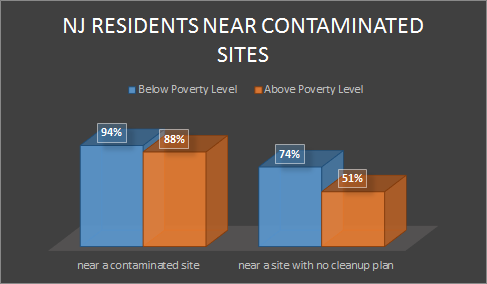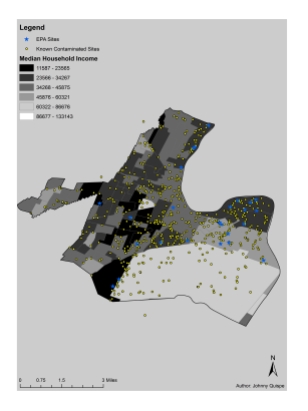This past month national attention was given to Flint, Michigan for an inexcusable year of lead contamination to its water source. What occurred in Flint was a failure of responsibility by elected and appointed officials at different levels of government. The result? A city of nearly a hundred thousand (100,000) exposed to unacceptable levels of lead with incalculable damage to their health. Unfortunately, what has been done is done and now the city must invest in infrastructure, health studies, aid to families, and redevelopment in to attempt to do right by its residents. This horrific case must be a wake-up call for the United States, in particular, its older states with antiquated plumbing, infrastructure, and a history of industrial contamination, such as New Jersey.
New Jersey, one of the original 13 colonies, the birthplace of the American Industrial Revolution, and now the state with the highest population density in America is in need of a comprehensive approach to overcoming its industrial contamination and probable public health problems. New Jersey has more than 14,000 known contaminated sites (NJDEP) ranging from gas station spills, small historic industrial contamination, to United States Environmental Protection Agency Superfund Sites. Where exactly are these are contaminated sites and who is living by them (See Figure 1)?

Figure 1. New Jersey’s Known Contaminated States (NJDEP) relative to Median House Household Income (ACS 2013)
In a paper published last month the authors found that extreme emitters are likely impacting Environmental Justice (Definition Below) communities even more significantly than we may have previously thought. These findings suggest that low-income and minority communities are experiencing a disproportionate exposure to environmental hazards compared to higher-income communities. In New Jersey, oversight for contaminated sites has transferred from NJDEP to private consulting firms with a Licensed Site Remediation Professional (LSRP) in what seemed to be an effort to expedite the process and provide efficient oversight and remediation. This switch followed a vote by the New Jersey State Legislature in 2009 to outsource the work to private firms. It has yet to be seen that this system provides much efficiency since most firms will go for the site with big contracts while other “less popular” and many times more important sites slip between the cracks.

Figure 2. Percentage of New Jerseyans above and below poverty level living near a contaminated site without a cleanup plan. (ACS 2013, USEPA, NJDEP, Census Bureau)
Environmental Justice- is the fair treatment and meaningful involvement of all people regardless of race, color, national origin, or income with respect to the development, implementation, and enforcement of environmental laws, regulations, and policies. EPA has this goal for all communities and persons across this Nation. It will be achieved when everyone enjoys the same degree of protection from environmental and health hazards and equal access to the decision-making process to have a healthy environment in which to live, learn, and work.-USEPA
Camden and Newark have both had early economic and industrial success throughout the industrial revolution but left to pay the price of business. Over time many of the national corporations that called these cities home have left, crime rates, and poverty levels have increased, making it difficult for redevelopment. An analysis examining economic and demographics in relation to contaminated sites have shown that areas where the majority of its residents are low-income have more unresolved contaminated sites.
For example, in 2002 a school district report for Camden found that 7 public school building were found to have high levels of lead in their water supply stemming from its old piping. 14 years later the school’s water fountains are out of commission and the school district is spending $75,000 a year on bottled water for students. How is it possible that the necessary upgrades have not been completed to provide one of the most essential needs for these students?
The recurring slashing of the state budget by Governor Chris Christie has pushed NJDEP to its breaking point with a diminished staff, resources, and a system that is unable to fulfill its duties to the people of New Jersey and the environment. The state is not only to blame since federal spending for USEPA’s Superfund program has been cut repeatedly from its inception in 1996 and its Trust Fund has been depleted since 2003. ( See Figure 6) With around 150 Superfund sites and 113 of these on the National Priority List (NPL) New Jersey is in dire need of funds to remediate and remove these sites from the NPL. Superfund was based on the principle that polluters, not taxpayers, should pay to clean up toxic waste sites not for hardworking American taxpayers to carry the burden for the mishaps of industries that use hazardous substances. These cuts greatly have greatly affected the amount of money USEPA can put towards superfund research, remediation, outreach, and several other indispensable functions of the remediation process.

Figure 6. US EPA’s Superfund funding history
New Jersey’s main cause of lead poisoning comes from old homes and apartment complexes that used lead-based paint. Many of these homes are located within in areas with contaminated sites and low-income communities. In 2004, New Jersey officials created the Lead Hazard Control Assistance Fund (LHCAF) to help allocate resources to inspect houses and apartments, emergency relocations for families, education and the removal of lead from houses and apartments. Since its inception over fifty million dollars has been taken from it to help balance the state’s budget, leaving it with only one hundred and eighty thousand for both this year and next year. In the past year a bill to put ten million dollars into the LHCAF has come across Governor Christie’s desk and he has decided to veto it. This veto leaves thousands of children and families at risk of lead poisoning, many of which do not have the ability to move to another place.

Lead paint peeling off wall- Source
The costs of renewing our infrastructure are already well underway and have the potential to be even higher with several detrimental public health implications. New Jersey needs new mandates and to allocate funding into these communities and the essential programs needed to provide the necessary support and protection of human health. The solution isn’t simply to tax the people of New Jersey, rather we must shift back to our polluters pay system, work with developers and homeowners to ensure homes are kept to standards, and implement an adequate system for oversight. Too often are our vulnerable communities put on the frontlines and not looked after. New Jersey must take lead in cleaning up contaminated areas, lead-based paint from homes, and protect our children and vulnerable populations or pay for it with the health of our children.
Special Thanks to Stephen Epstein in his help with this post.



